Catholic Customs
 |
 |
 |
 |
 |
 |
 |
Bringing in the Yule Log
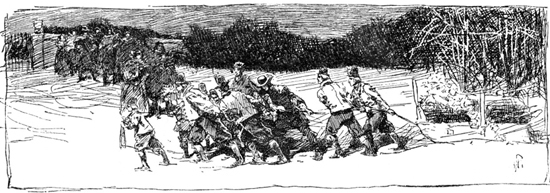
Come, bring with a noise,
My merry, merry boyes,
The Christmas Log to the firing…
Thus is announced the hour for the Yule Log to enter the Christmas festivities. The ancient Goths, Saxons and Scandinavians called the winter solstice festival Jul or Yule and celebrated it with huge bonfires in honor of their god Thor.
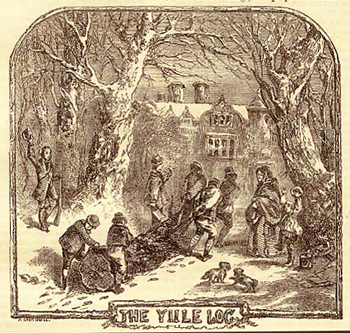
The log was often large,
calling for many menfolk to drag it in
The Yule Log was a large log – often a whole tree trunk – large enough to burn all twelve days of Christmas. According to old French and English lore, the log should be made of oak, but in other countries fruit trees were used. In some areas, the Yule Log was chosen and felled at Candlemas on February 2 and kept in a safe place all year so that it was dry by Christmas. (1)
In poorer homes where it was not possible to have a large log, a smaller log was used and placed on the fire for a short time on each night of the Twelve Days of Christmas – from Christmas Eve until the Eve of the Epiphany (January 5) – so that it lasted all twelve days. (2)
Lighting the Yule Log
As darkness covered the land on Christmas Eve, families gathered together to solemnly light the Yule Log in a traditional ceremony that varied from region to region. The youngest and the oldest family members fulfilled their roles by carrying the log to the hearth.
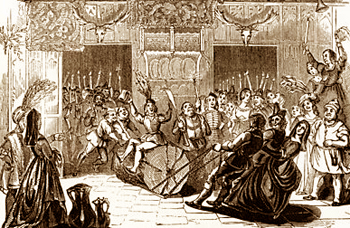
Merriness reigns as the yule log enters the medieval manor; below, a priest blesses the village Yule Log
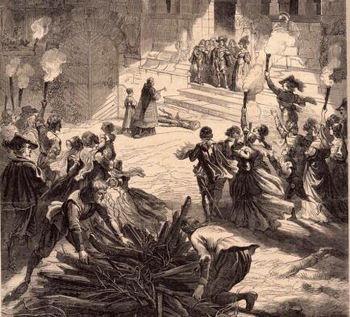
Being lit during the sacred days of Christmastide, the Yule Log was also believed to bring blessings on the harvest. Corn, wine, or ale was often poured on the log as it burned in order to obtain this end. (3) How fitting indeed that the days honoring Our Lord’s birth in Bethlehem, the city of Bread, should be days propitious for imploring God for a fruitful harvest.
Medieval English lords developed magnificent ceremonies to bring in the Yule Log. Early in the evening on Christmas Eve, the servants went out to the woods to take the log from its resting place. They then triumphantly dragged the log to the lord's castle announcing their presence with joyful shouts and merry laughter. Any passersby halted and doffed their hats in salute of Christmas and the Yule Log. Often the logs were of such a large size that horses drew them into the hall.
In the baronial hall, minstrels greeted the log with songs in praise of Christmas and the log that would bring light to the great feast. If minstrels were not present, each family member took turns sitting upon the log and singing a verse of a Christmas song. One of these ancient songs began by hailing Christ and Christmas:
Welcome be thou, heavenly King,
Welcome born on this morning,
Welcome for whom we shall sing
Welcome Yule.
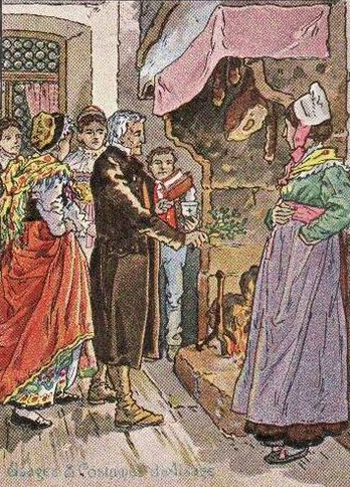
A solemn blessing by the family head in France
Even the highest members of society participated in these ceremonies. In olden times, the magistrates of the city of Aix carried a large Yule Log in procession to the palace of the Count of Provence as a good-will offering. The Count graciously received the symbolic gift and invited the magistrates to a feast in the great hall of the palace. (4)
French grandfathers often began the Yule Log ceremony by pouring three libations of wine over the Yule Log as they recited a prayer asking for health, wealth and good fortune for the family. The youngest child then drank a sip of wine to the newly lighted fire followed by all of the rest of the family. (5)
In Provence, the blessing that the grandfather recited as he threw his wine into the flames was:
Be happy! Be happy!
May le bon Dieu make us happy.
Even though we are gone next year,
Let us be happy today! (6)
In Brittany, the youngest child joined the grandfather in reciting this ancient prayer:
Christmas log, catch fire
Let us all rejoice.
Lord, give us Thy peace
And pour over us Thy blessing.
Lord, let us also
See the coming year.
And, if we are not one more,
May we not be less. (7)
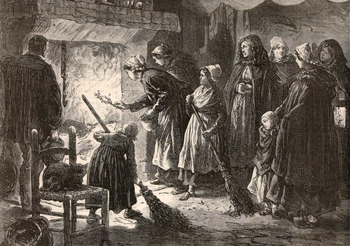
A ceremonial lighting in a French peasant home;
below, gathering around the Yule fire
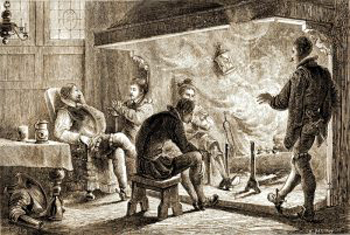
On Christmas Day, visiting neighbors and friends threw grains through the open door with the greeting, "Christ is born!" Anyone inside on whom the grains fell then responded, "He is born indeed!" a response that invited the visitor to enter and strike the log with a piece of iron. As the visitor struck, he solemnly recited, "For as many sparks as come out of you, let there be as many oxen, horses, sheep, goats, pigs and bee-hives." (8)
In Lorraine and regions of France near Germany, some families suspended their burning Yule Logs from the ceiling. (9) The Yule Log was adopted as well by peoples of southern Europe in Spain, Portugal and the Italian regions of Campania and Toscana where many families had Yule Logs that burnt either in the church yard or inside family homes in the early hours of Christmas day.
In some Spanish towns, the boys drug their Yule Log through the town stopping at every house to collect sweets and filling the streets with noise as they beat the log energetically. (10)
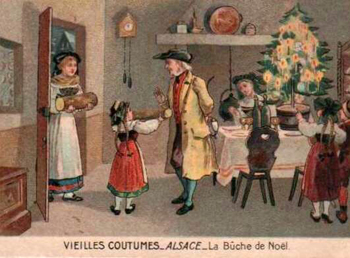
Yule Logs - small & large
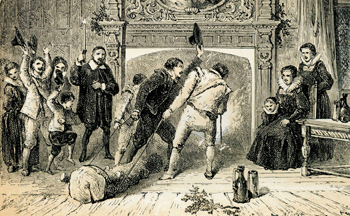
The ashes and charred remains of the Yule Log were always preserved in a safe place and later scattered in the fields as a protection against grain diseases, strewn in the hearth fire during storms to prevent lightening, and sprinkled onto the food of the sick to help them to heal. In some places, it was believed that any house that contained a piece of the Yule Log would not suffer from fire in the coming year.
Our Catholic ancestors cherished these flaming Christmas logs because they were a symbol of Our Lord, the bud from the tree of Jesse. Surely the Christ Child showered many blessings upon those Catholic homes which honored Him with these ceremonies.
The sacredness of the night of Christ’s Birth gave a special blessing to these Yule Logs, and the ashes that were saved were a sign of the blessings and joy of Christmas that remained in the homes of our Catholic forefathers throughout the whole year.
How wonderful it would be to see burning Yule Logs on the hearths of Catholic homes once again! If lit with ceremony, the Yule Logs would add to our Christmas celebrations a sacrality that would prepare our hearts to duly welcome our glorious Infant King.
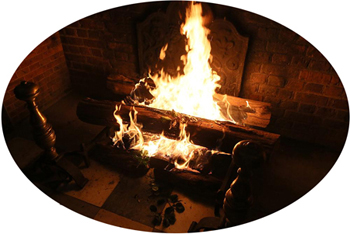
- Francis X. Weiser, The Christmas Book (New York: Harcourt, Brace and Company, 1952), p. 115.
- Elisabeth Luard, European Festival Food (London: Bantam Press, 1990), p. 64.
- A Celebration of Christmas, ed. Gillian Cooke (New York: G. P. Putnam’s Sons, 1980), p. 64.
- William S. Walsh, Curiosities of Popular Customs and of Rites, Ceremonies, Observances, and Miscellaneous Antiquities (Philadelphia: J. B. Lippincott Company, 1898), pp. 1014-1015.
- Mary P. Pringle and Clara A. Urann, Yule-tide in Many Lands (Boston: Lothrop Lee and Shepard Co., 1916), p. 70.
- Dorothy Gladys Spicer, Festivals of Western Europe (New York: The H. W. Wilson Company, 1958), p. 62.
- Christmas in France (Chicago: World-Book-Childcraft International, 1980), p. 55.
- Walsh, Curiosities of Popular Customs, pp. 1016-1017.
- Pringle and Urann, Yule-tide in Many Lands, p. 70.
- A Celebration of Christmas, p. 65.

Posted January 27, 2023
______________________
______________________
 |
 |
 |
 |
 |
 |


